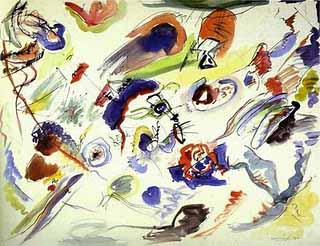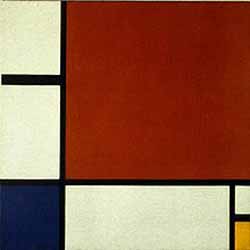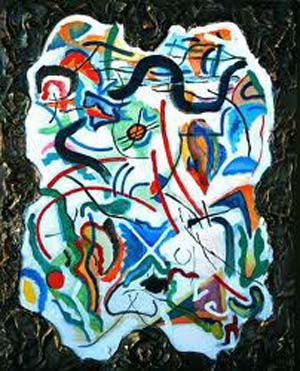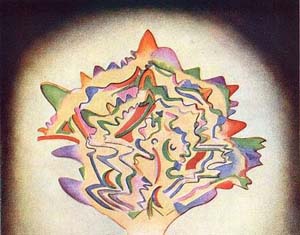 |
Art & Architecture
Abstract Art & Theosophy
Cunha Alvarenga
One cannot deny the occult, magical and satanic influence on the most representative currents of modern art such as Surrealism. Surrealism, according to Hans Sedmayr,(1) is nothing but subterranean-realism or the demonic basement of art. I believe that the same can be said about Abstract Art.

Kandinsky's watercolor of 1911, the first known work of abstract art |
The first known work of abstract art was a watercolor by Russian painter and theorist Wassily Kandinsky in 1911. One year later, this same artist authored the book Concerning the Spiritual in Art, which provided the first theoretical foundation for abstract art.
In it, he openly acknowledges that his art theories are based on the occult teachings of Helena Blavatsky, the founder of Theosophy (2) and author of The Secret Doctrine. “I got everything from the Secret Doctrine [of Blavatsky], he wrote in 1918. (3) Blavatsky’s work is so fundamental to modern magic that 1888, the date of its publication, is considered a landmark year in theosophist circles.
Although Russian by birth, Kandinsky belonged to the German expressionist movement know as Die Brücke [The Bridge] founded in 1905. Its members included Emil Nolde, Max Pechstein, Ernst Ludwig Kirchner and Karl Schmidt-Rottluff. Rejecting their “bourgeois” backgrounds, they adopted a bohemian lifestyle with free love and frequent nudity in their art. This group was also strongly influenced by magic through the occult theories of Blavatsky, Anne Besant and Charles Webster Leadbeater.

Mondrian's colors, forms and lines have an occult symbolism; above, a 1930 painting |
Another forerunner in Abstract Art is Dutch painter Piet Mondrian, known for his work in the form called Neoplasticism. He was also a theosophist and a close friend of the philosopher and mystic Schoenmaekers, author of many works on “rationalist mysticism” including The New Image of the World, which proposes a whole system of universal symbolism that attempts to explain the meaning of colors, forms and lines.
“I am always driven to the spiritual,” Mondrian stated. “Through Theosophy I became aware that art could provide a transition to the finer regions, which I will call the spiritual realm.” (4)
In antiquity, Hermes Trismegistus (Hermes thrice great) had already tried to explain that spiritual realm “What is below is equivalent to what is above, and what is above is equivalent to what is below.”(5) Goethe corroborates the same magical occult thinking in other words: “*Nothing's inside, nothing's outside. For the inside is the outside.” In affirming this, Goethe did nothing but repeat a principle of the Kabala. For this reason, there is a curious similarity between these treatises on the theory of the form and those of the so-called occult sciences.
Theosophy has its own way to explain the psychic processes. On the one hand, a book titled Thought Forms by Anne Besant and C.W. Leadbeater, affirms that there is a gradual and subtle continuity in every plan of the universe from the spiritual to the mechanic; then it presents rows of colored squares that supposedly represent the forms of thinking. It is an addition to theosophist theories on the symbolism of colors.
On the other hand, in the Traité Élementaire de Science Occulte, Gerard Encausse (a French spiritualist and ‘bishop’ of the Gnostic Church known for his books on magic, the Kabala and the Tarot,) makes many analogies between graphic forms and psychic elements. (6)
Painting in state of trance
It is a historical fact that since the mid 19th century, the modern art movements were influenced by a wave of Asian mysticism and philosophy. German Expressionism, the cradle of Abstract Art, was also deeply immersed in Theosophy and Eastern Pantheism. What Modern Art lost by rejecting Christianity was replaced by Taoism, Brahmanism, magic, astrology and the bogus Asian mysticism and philosophy. Art cannot live without religion.
Kandinsky along with many other Expressionists of that time considered art as a means to exercise the “divine force.” ”Art is a force and a work of art springs from the artist’s soul in a mysterious and secret way,” Kandinsky affirmed.
According to the testimony of Herbert Read, Picasso painted in a state of trance. So also did Kandinsky and Fernando Pessoa. It was a common practice among the modern artists. “A great square without angles or sides” is a supreme aspiration on the path toward the infinite, according to the thinking of Laotsé, a mystic philosopher of ancient China, whom those initiated into the “secrets” of Abstract Art believed to be divine.

There are similarities between Kandinsky's painting, above, and Besant's Form of Thought, below
 |
It seems to me that this definition of infinite is as obtuse as the definition of ''nothing' given by an urban philosopher, “Nothing’ is a knife without a blade and without a handle.” This sensation of being placed before something irrational and obtuse is what the normal man feels when he is put before a work of modern art.
To understand the deepest origins of the abstract painting, we need to link it with the occult and magic. When people view those chaotic displays of forms and colors, they have no notion of the occult science that inspires those works.
As an ardent follower of Madame Blavatsky, Kandinsky most likely also followed the theosophical experiences of Anne Besant and Leadbeater as revealed in their books Thought Forms and Man, Visible and Invisible.
Comparing the illustrations in these two works, published in 1903 and 1905, with the abstract art works of Kandinsky that he began to paint in 1911, one finds marked similarities. Indeed, the parallels are so obvious that an observer is forced to conclude that Kandinsky’s art relies more on the theories of theosophy than on being executed in a state of trance or having some secret mysterious origin. (7)
This conclusion is reinforced when we compare that what Kandinsky calls “the language of forms and colors” with C.W. Leadbeater’s theory on astral colors. He proposed that every man had an aura that resided on the astral plane, and that each astral color and shade had a different occult meaning. (8)
Then we begin to realize that Abstract Art started neither with Kandinsky, considered its leading figure, nor with the German expressionist movement, nor with Mondrian, nor with the Bauhaus group of modern architecture. Rather, it seems to be a byproduct of astral manifestations revealed by theosophy.
1. Art du Démoniaque et Démonie de l’Art, Archivio de Filosofia - Organo dell’Istututo di Studi Filosofici.
2. Theosophy, literally "god-wisdom," attempts to synthesize knowledge of the laws that govern the universe into a unified worldview by means of “hidden” or occult science.
3. Carel Botkamp, Mondrian: The Art of Destruction, (London: Reaktion Books, 2001) 2nd ed., p. 111
4. Juan Eduardo Cirlot, La Pintura Abstracta, p. 60
5. Apud J. Gaspar Simoes, Vida e Obra de Fernando Pessoa, p. 39.
6. Juan Eduardo Cirlot, La Pintura Abstracta, p. 60
7. T.H. Robsjonhson-Gibbings, Mona Lisa’s Mustache, p. 151.
8. Charles Leadbeater, Man Visible and Invisible, paragraph 131 online

Published in Catolicismo n. 35, November, 1953
Translated and adapted by TIA desk
Posted July 4, 2011

Related Topics of Interest
 Esoteric Characteristics of Modern Art Esoteric Characteristics of Modern Art
 Vertical versus Circular Architecture Vertical versus Circular Architecture
 Medieval Cathedrals & Modern Churches Medieval Cathedrals & Modern Churches
 Living the Spirit of Reparation Living the Spirit of Reparation
 Trash Art at St. Mary Magdalene Church Trash Art at St. Mary Magdalene Church
 The Taste for the Macabre in Today's Art The Taste for the Macabre in Today's Art
 The Subtle Invasion of Satanism The Subtle Invasion of Satanism
 Modernization, Brutalization, Primitivism Modernization, Brutalization, Primitivism

Related Works of Interest
|
|
Art & Architecture | Hot Topics | Home | Books | CDs | Search | Contact Us | Donate

© 2002-
Tradition in Action, Inc. All Rights Reserved
|
 |

|